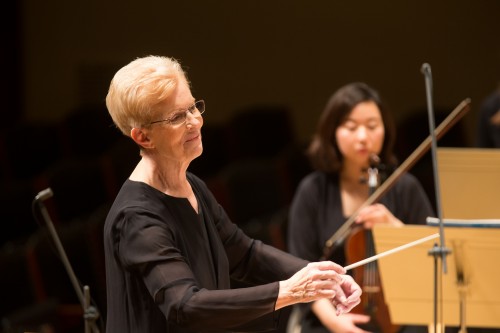Ann Howard Jones conducting the Boston University Symphony Orchestra
by Andrea Schuler, Summer@Eastman Program Coordinator
Summer@Eastman’s Advanced Choral Conducting institute is a perennial student favorite and one of the most eagerly-anticipated classes on the summer calendar. The five-day course takes a group of 14 student conductors (and a resident choir) through study and analysis of a different choral masterwork each summer; Eastman’s Director of Choral Activities William Weinert brings in notable guest artist-teachers to help students explore the music and the conducting process. This year the institute will focus on Johannes Brahms’s Ein deutsches Requiem, and classes will be led by Dr. Ann Howard Jones, Professor Emerita of Boston University.
Dr. Jones brings decades of experience and impeccable choral credentials to the podium. She was an assistant to the legendary choral conductor Robert Shaw for fifteen years at the Atlanta Symphony Orchestra Chorus, the Robert Shaw Singers and Festival Singers, and the Robert Shaw Institute. After leaving Atlanta, she taught for nearly twenty-five years as a professor and Director of Choral Activities at Boston University, also coaching choral singers every summer at the Boston University Tanglewood Institute’s Young Artists Vocal Program. In recognition of her work, Dr. Jones has been honored with the 2011 ACDA Robert Shaw Award and the 2014 Distinguished Service Award from Chorus America. She officially retired from Boston University last year but is still much in demand as a clinician and teacher. We are thrilled to welcome her to Eastman this summer!
I asked Dr. Jones a few questions about conducting, Brahms, and how she plans to structure the Advanced Choral Conducting institute:
What was the best advice you ever received about conducting (in general, and/or the Brahms Requiem)?
I think of three things about conducting in general that I have learned and never forgotten from long-ago teachers:
The first is to PREPARE! This means the conductor understands the piece structurally or formally, harmonically, textually, musically; knows all the parts and how they fit together, and has a concept of the forward motion of the work as a whole and individual movements as they relate to the whole. The second is to set a proper tempo and to establish carefully the tempo relationships in the work. One teacher told us that the most important thing a conductor has to do is to set an appropriate tempo. Number three: once the piece is rehearsed and the disciplines (pitch, rhythm, dynamics, diction, balance) are in place, then it is important to let the composer and the composition as he/she conceived it be heard. The conductor has to learn how to stay out of the way–to think of the conductor’s role as one of facilitating and guiding the work artistically.
What do conductors have to keep in mind when conducting an orchestra and a chorus together? How does conducting a combined orchestra and chorus differ from the experience of leading an orchestra or chorus on its own?
When combining an orchestra and chorus, the most important change is that now there is text to deal with. It is important to figure out a way to allow the sounds of the text to penetrate the orchestral texture; sometimes this requires adjustment in the dynamic markings in the orchestral parts.
In general, the orchestra [for a Requiem or other combined work] needs the conductor more than the chorus does. The chorus has had weeks of preparation, usually, and the orchestra is fortunate to have a full rehearsal without the chorus, one rehearsal with the soloists (depending on the work), and then a tutti dress before the actual concert. Transitions and seams need special emphasis so that the orchestra understands how they will work in performance. It is important that the chorus “makes” tempo, functions without elaborate cueing, and understands the need for it to be dependable in matters of rhythm, dynamics, pronunciation, tone quality—all the things that have been prepared in rehearsal ahead of the orchestral arrival.
The conductor has to keep more things in mind with the combined forces. The issues are the same, and the strategies are mostly the same, but the managing of the work is more complicated.
How is conducting Brahms different than conducting other great choral works? What is essential when conducting the music of Brahms that might not be so readily apparent to a conductor approaching this work for the first time?
Essential in Brahms is color and rubato. The sound of the piece in the conductor’s ear is different from many other works because of the rich harmony, the complex counterpoint, and the need for balancing all the forces that are competing for the ear of the listener. Bending the rhythm from time to time is also important. The conductor has to decide where the music pulls back a little and where it moves ahead a little within the framework of the phrase, always with regard to style and taste. Because the piece requires a great deal of the chorus, the precision with which the chorus sings, the different colors it uses and the range of the dynamics involved is extremely important and all require a wider compass than many works.
Conductors could spend a lifetime exploring the Brahms Requiem, but this workshop only runs for five days. What is your focus in this context, where do you start, and what do you hope to accomplish with your students? What are your musical and technical goals for the week?
Since we have only a few days, it is my hope that we can discuss the work’s structure, and, based on that analysis, we can break the piece down so that it is manageable in rehearsal. Serious discussions of tempo and tempo relationships will be required, and I will try to help the members of the class with a conducting gesture that is clear, well-informed, and musically responsive to the demands of the work.
—
The Summer@Eastman 2016 Advanced Choral Conducting institute runs July 11-15. Visit http://summer.esm.rochester.edu/course/advanced-choral-conducting-brahms-requiem/ for information and registration details.
